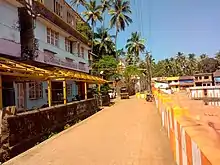Sodhe
Sodhe also called Sodha, Sonda or Swadi is a village near Sirsi in the Uttara Kannada district of Karnataka in India.
Sodhe
Sonda | |
|---|---|
village | |
 Sodhe Location in Karnataka, India | |
| Coordinates: 14°43′35″N 74°47′57″E | |
| Country | |
| State | Karnataka |
| District | Uttara Kannada |
| Government | |
| • Type | Panchayat raj |
| • Body | Gram panchayat |
| Languages | |
| • Official | Kannada |
| Time zone | UTC+5:30 (IST) |
| ISO 3166 code | IN-KA |
| Vehicle registration | KA |
| Nearest city | Sirsi |
| Website | karnataka |
Matha
Sodhe is the headquarters of the Sodhe Matha, one of the Ashta mathas established by Sri Madhvacharya, the famous Dvaita philosopher. The matha at Sodhe village was set up by Swami Sri Vishnu Tirtha.
The Brindavana of Swami Vadiraja Tirtha can be found at Sodhe. The main deities worshipped at the Sodhe matha are Lord Bhuvaraha and Lord Hayagriva. Sri Bhuta Raja is also worshipped here.
Other places to visit near Sodhe include the Sri Trivikrama Temple, the Tapovana where Sri Vadiraja Swamy used to meditate, Swarnavalli Matha and Sahasralinga which has thousands of Shiva Lingas on the banks of the river Shalmala. Jain monasteries,[1] (Swadhi jain matha) and Digambar Jain temples are also situated at Sodhe.
Parampara of Sodhe Matha
- Sri Madhvacharya(1275-1317)
- Sri Vishnu Tirtha(1317-1325)
- Sri Vyasa Teertha(1325-1339)
- Sri Vedagarbha Teertha(1339-1349)
- Sri Varesha Teertha(1349-1357)
- Sri Vamana Teertha(1357-1365)
- Sri Vasudeva Teertha(1365-1372)
- Sri Vedavyasa Teertha(1372-1380)
- Sri Varaha Teertha(1380-1389)
- Sri Vedatma Teertha(1389-1401)
- Sri Vishvavandya Teertha-I(1401-1421)
- Sri Ratnagarbha Teertha(1421-1424)
- Sri Vedanga Teertha(1424-1427)
- Sri Vidyapati Teertha(1427-1440)
- Sri Vishvavandya Teertha-II(1440-1459)
- Sri Vishva Teertha(1459-1465)
- Sri Vittala Teertha(1465-1472)
- Sri Varadaraja Teertha-I(1472-1479)
- Sri Vageesha Teertha(1479-1518)
- Sri Vadiraja Tirtha(1518-1600)
- Sri Vedavedya Teertha(1600-1616)
- Sri Vidyanidhi Teertha(1616-1620)
- Sri Vedanidhi Teertha(1620-1649)
- Sri Varadaraja Teertha-II(1649-1674)
- Sri Vishwadhiraja Teertha(1674-1689)
- Sri Vadivandya Teertha(1689-1707)
- Sri Vishwavandya Teertha-III(1707-1724)
- Sri Vibhudavarya Teertha(1724-1739)
- Sri Vishwadhishvara Teertha(1739-1789)
- Sri Vishwesha Teertha(1789-1803)
- Sri Vishwapriya Teertha(1803-1865)
- Sri Vishwadheesha Teertha(1865-1899)
- Sri Vishwendra Teertha(1899-1943)
- Sri Vishwottama Teertha(1943-2007)
- Sri Vishwavallabha Teertha(2007)(Present Pontiff)

Prehistoric rock art
Rock art engraved during pre-historic times is found near Sodhe.[2] [3] and these ancient drawings are dated to c. the first millennium BCE. In these drawings, double lined two squares with intersecting loops are engraved; such drawings can also be found at Hire Benakal, Gavali, Karnataka[2] and such drawings have some resemblance to present day rangavalli.
History
Sodhe or Sonda has a long, recorded history. Sonda kingdom was established in 1555 by Arasappa Nayaka, a Jain chieftain (1555-1598). Sonda was ruled by Sonda Nayakas for more than two hundred years (1555–1763). Arasappa Nayaka as vassal of Vijayanagara Dynasty till the fall of Vijayanagara to Bahamanis in 1565. He continued as the subordinate ruler of Adil Shah till his death in 1598. Arasappa Nayaka established Vadiraj Matha in Sonda which is still in existence. Shivaji, the Maratha Emperor conquered Sonda during 1674 and gave it back to Sonda ruler, Sadashiva Nayaka. Hyder Ali, the Sultan of Mysore attacked Sonda in 1763 and totally destroyed it. The last chief of Sonda, Immodi Sadashivaraya escaped to Portuguese Goa.[1] The ruins of the fort which was protecting Sonda is covered with overgrowth of shrubs.[1] According to Imperial Gazetteer of India, five carved pillars, approximately 3 feet high are the remains of the Sonda palace.[1]
References
- "Sonda:Imperial Gazetteer of India, Vol.23, (1908)". uchicago.edu. p. 82. Retrieved 6.8.2012. Check date values in:
|access-date=(help) - Dr. A, Sundara. "Pre historic art in Karnataka". Indira Gandhi National Centre for Arts(IGNCA). Archived from the original on 15 July 2013. Retrieved 6 August 2012.
- kannada, classical.org. "Mural Paintings of Karnataka". classicalkannada.org. Archived from the original on 12 April 2013. Retrieved 6 August 2012.